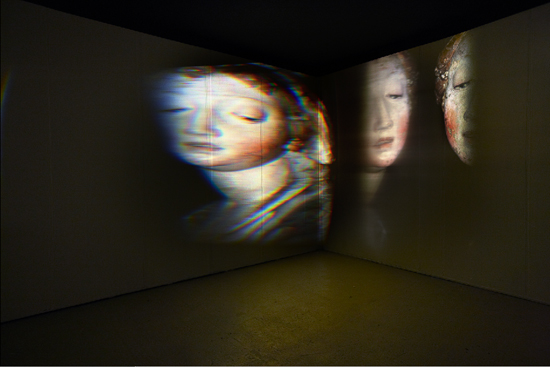Michaela Melián
Shedhalle / Exhibitions / The F-Word / Artists / Michaela Melián

Michaela Melián: Sarah Schumann und Silvia Bovenschen, 2012 (Installation, detail) Foto: Susi Bodmer
Michaela Melián (born in 1956, lives near Munich) is artist and musician and has repeatedly concerned herself with forgotten female figures from the history of medicine, industry, or art. In her installational stagings, she creates highly aesthetic spaces of tension and multilayered systems of reference by way of drawing and sculpture, film and sound. As a musician she has released two albums and is cofounder of the band F.S.K. (founded in 1980)
Sarah Schumann und Silvia Bovenschen
3-Channel Video-Installation, 2012
The Berlin exhibition Künstlerinnen international 1877–1977, which was held in 1977 and showed works by 265 artists, was the first art exhibition in Europe with exclusively female participation. Central to Michaela Melián’s new work Sarah Schumann und Silvia Bovenschen is a lengthy interview with two of the co-initiators of the exhibition: the artist Sarah Schumann and writer Silvia Bovenschen, who met at the time. In its spatial staging, the combined audio-video installation seems like a visit to the home of the couple Schumann/Bovenschen: captured in a tableau vivant, we see the two sitting beneath a painting made by Schumann in 1977 depicting Bovenschen. A second film shows a hand leafing through the catalogue of the exhibition from 1977. Now and again, as if we were walking through the Berlin pre-war apartment of the two, we see paintings by Sarah Schumann. The voices of the two tell of challenges and obstacles they experienced: it is a visit with a generation of activists from German women’s movement from the 1960s and 1970s which decisively shaped feminist discourse. And it is a visit with two artists who with their texts and images promote a public shift of perception. As an artist, like many of her contemporaries, Sarah Schumann never received much recognition for their work. Her collages were, even for the women’s movement, too provocative in their affirmation of female eroticism and beauty. In their refusal to conform, Bovenschen and Schumann attest to the multivocality of feminism. Using the example of the now forgotten exhibition Künstlerinnen international 1877–1977, Silvia Bovenschen puts it this way: ‘An exhibition creates a communicative space that takes up a tradition and passes it on. But what did not happen is . . . Somehow just a short while after the exhibition nobody was talking about the show anymore, even the women themselves. It’s almost spooky. And that seems to confirm the history of the lack of a woman’s history. It’s like a hiccup.’ (Silvia Bovenschen and Sarah Schumann, in the interview with Michaela Melian, 2012)
In her artistic research, Michaela Melián undertakes once again a journey to the recent history of the twentieth century and illuminates the forgotten and marginalized, the brief memory of our generation of those who have gained from the past and how this memory produces simplifications and gaps.

Michaela Melián: Ignaz Guenther House, 2002 (Installationsansicht Shedhalle 2012) Foto: Susi Bodmer
Ignaz Guenther House
Audio-slide installation, 2002
Slide projector, 80 slides, prism, motor, soundtrack
Her work Ignaz Guenther House, an audio-slide installation, consists of a house music piece produced by Melián and 80 slides of a Rococo sculpture of St. Mary Magdalene (1755), carved in 1755 by Ignaz Guenther. The images of Mary Magdalena are refracted by a prism rotating before the lens in semicircles and projected into the space in constant movement. The saint becomes a dancer. Her image oscillates between shyness, ecstasy and trance, between a girl, Mad(d)onna, and disco queen. Melián fragments and multiplies this ambiguous Magdalene figure and combines it with her own house piece that is based on a piano prelude sample by Johann Sebastian Bach: ‘to give the music a body, something sculptural’. (Freundliche Übernahme: Ein Interview mit Michaela Melián von Aram Lintzel’, Texte Zur Kunst: Sounds, No. 60, 2005. p. 128.) House, a form of electronic dance music that began in the 1980s at Chicago’s’ Warehouse, knows neither start no end: ‘House radicalises soul by taking recourse to the oldest gospel sources, that always as an unseverable Möbius strip spiritualised the erotic and eroticised the spiritual ... House music is utopian transgender /race/class music of salvation ... My house is your house.’ (Didi Neidhardt, ‘Ignaz Guenther House...Fädenziehen...’, Michaela Melián: Triangel, ed. by Bettina Dziembowski / Silvia Eiblmayr / Nicolaus Schafhausen, New York: Lukas&Sternberg, 2003. p.117.) House, with its many influences and origins, from gospel, Latin, soul, funk, and disco, is also a social music in which the heterogeneity of culture, ethnicity, class, and gender reverberates.
